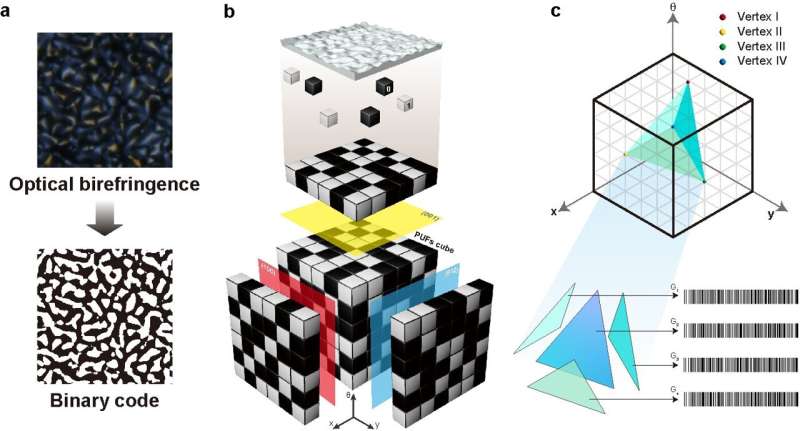This article has been reviewed according to Science X's editorial process and policies. Editors have highlighted the following attributes while ensuring the content's credibility:
fact-checked
peer-reviewed publication
trusted source
proofread
Random wrinkles for opto-physical unclonable functions

The convergence of digital technology and the internet has led to the emergence of complex digital networks utilizing ubiquitous electronic devices such as mobile phones and smart home appliances. As a result, we can access and exchange information from anywhere using technologies such as the Internet of Things (IoT), big data, and cloud computing.
However, this information technology environment is prone to security breaches such as personal information leaks and cyber-attacks, so it is necessary to build a strong and safe security system. Additionally, security issues associated with traditional software-based digital encryption require more secure and unclonable hardware-based security.
In a new paper published in Light: Science & Applications, a team of scientists led by Prof. Jun-Hee Na from Soft Matter & Device Research Group in Chungnam National University, Korea has developed an optical physical unclonable function (PUF) with random wrinkles structure.
PUF (physical unclonable function) is a technology that has unique value, like a person's fingerprint or iris. This system generates random digital values that are difficult to predict by utilizing characteristics formed by process deviations in semiconductor process characteristics.
Recently, research has reported on developing optical PUFs using chemical and material technologies such as luminescent nano/microparticles to generate optical signals and exploit transmission, reflection, and diffracted light by surface microstructures and optically anisotropic materials.
This study presents a three-dimensional PUF based on a unique birefringent wrinkle structure. Reactive mesogens (RMs) are an optically anisotropic medium that can produce polymer networks with uniform orientation via photopolymerization through a reactor, making it useful for various optical applications.
This group achieves the highly random nature of unaligned wrinkles in optical PUF applications, which can produce inimitable patterns through diffraction by the birefringent properties of RMs. They demonstrate using the birefringence pattern generated by the random wrinkle PUF (rw-PUF) as a highly secure authentication key. The rw-PUF has application potential beyond authentication systems, including anti-counterfeiting and data storage technologies.
This rw-PUF can be voxelized in three dimensions along the optical axis. By utilizing the birefringent properties of liquid crystals, we can see that the code that can be obtained varies depending on the angle of the crossed polarizer. When these codes are stacked, a three-dimensional random cube is formed.
This research team presents two authentication applications using this three-dimensional cube. First, a tetrahedron can be formed by setting four arbitrary coordinates of the three-dimensional cube data. This tetrahedron can be used as a "three-dimensional password" like a jigsaw puzzle. Second, a tetrahedron has four faces. The binary data held by the four sides can be converted into a one-dimensional code and used in a security system through "continuous authentication."
The proposed authentication method shows a wide range of applicability, covering secure communications, anti-counterfeiting measures, access control systems, etc.
More information: Kitae Kim et al, Voxelated opto-physically unclonable functions via irreplicable wrinkles, Light: Science & Applications (2023). DOI: 10.1038/s41377-023-01285-1
Journal information: Light: Science & Applications
Provided by Chinese Academy of Sciences





















